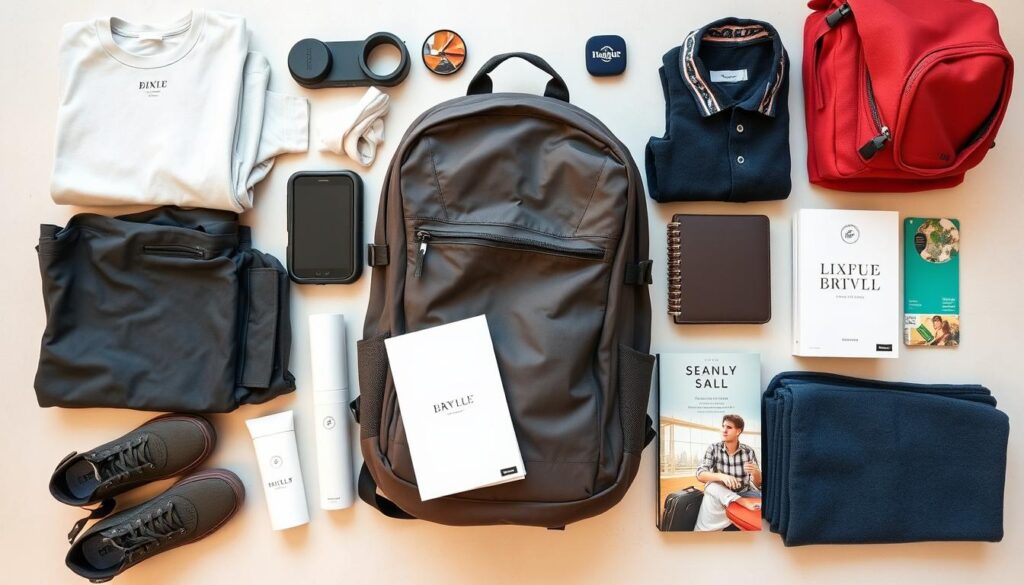Travel The World: Your Ultimate Adventure Guide
Did you know over 1.4 billion people traveled internationally in 2018? They made $1.7 trillion in global tourism revenue. The world is full of adventures, from Machu Picchu to Tokyo and Bali’s beaches. This guide will help you make your travel dreams come true.
Table of Contents
Starting a world trip needs careful planning. First, make a travel budget that’s realistic. List out what you’ll spend on things like flights, hotels, and food. This helps make sure your trip won’t break the bank.
After setting your budget, pick places that match your interests and budget. This is the next step.
Creating Your Travel Budget
Start by guessing how much flights will cost. Look for the best times to book flights to save money. Then, figure out the average cost of staying, eating, and doing things in your chosen spots. Remember to add in extra costs like travel insurance and visas.
Having a detailed budget helps you find ways to save money. You can then use that money for more fun things.
Choosing the Right Destinations
When picking places to visit, think about what you like to do and see. Look at the local culture and how much things cost there. Find places that offer great experiences without breaking the bank.
Use travel guides and blogs to find the best spots. Look for places that mix adventure, culture, and good value.
Best Times to Book Flights
When you book your flights can affect how much you pay. Booking early usually means cheaper flights. But, prices can change during holidays or big events.
Keep an eye on flight prices to find the best time to book. Being flexible with your travel dates can also help you save money.
By using these travel planning tips, you can plan a memorable trip that’s within your budget. And it will match your travel dreams.
Must-Have Travel Documents and Requirements
Going on an international trip needs careful planning. You must have the right travel documents and meet entry requirements. A valid passport and the correct visa are key to a good trip.
Before you go, find out what each country needs. Some places need extra international permits or travel insurance proof. Missing these can cause delays or even cancel your trip.
Here’s a checklist to help you with travel documents:
- Passport: Make sure it’s valid for 6 months after you return and has enough blank pages.
- Visa: Check visa needs for your destinations and apply early to avoid problems.
- Travel Insurance: Get a good travel insurance policy for medical, trip cancellations, and more.
- International Permits: See if you need special permits for driving, hunting, or certain areas.
By preparing your documents well, you’ll have a smooth trip. You can then enjoy your destination fully.
| Document | Requirement | Importance |
|---|---|---|
| Passport | Valid for at least 6 months beyond your planned return date | Necessary for international travel and entry/exit of countries |
| Visa | Research and apply for the appropriate visa type | Required for entry and stay in many countries |
| Travel Insurance | Comprehensive coverage for medical emergencies, trip cancellations, and more | Protects you from unexpected costs and provides peace of mind |
| International Permits | Depending on your activities, such as driving, hunting, or accessing specific areas | Ensures compliance with local laws and regulations |
Being well-prepared is key for a great international trip. With the right documents, you’re ready for a memorable journey.
“The world is a book, and those who do not travel read only a page.” – Saint Augustine
How to Travel the World on a Budget
Traveling around the globe doesn’t have to be expensive. With smart planning, you can see the world without spending a lot. This guide will show you how to find cheap places to stay, get around cheaply, and eat well without breaking the bank.
Money-Saving Accommodation Hacks
Finding affordable places to stay is key to saving money. Look into hostels, vacation rentals, or even house-sitting for big discounts. Also, join hotel loyalty programs to earn points or discounts on your stay.
Transportation Cost-Cutting Strategies
Transportation costs can add up fast. Use public transit like buses, trains, or metro systems to save money. Many places offer passes or cards that are cheaper than buying individual tickets. Try bike-sharing or walking when you can to cut down on costs.
Smart Dining While Abroad
Eating out can be pricey, but it doesn’t have to be. Skip the tourist spots and try local food from street vendors or grocery stores. Cooking your own meals with local ingredients is another way to save money.
“Traveling the world on a budget is all about being resourceful and creative. With a little planning and flexibility, you can enjoy unforgettable experiences without breaking the bank.”
Packing Strategies for Long-Term Travel
Starting a long-term journey is exciting, but packing can feel overwhelming. Don’t worry! Learning to pack lightly can make your travels easier and more enjoyable. By choosing versatile travel gear and versatile clothing, you can pack smarter and travel lighter.
For successful long-term travel packing, think minimalist. Don’t pack too much. Instead, pick items that can be used in many ways. Look for wrinkle-resistant, quick-drying fabrics that can be mixed and matched. This way, you can make different outfits from just a few pieces.
- Invest in a high-quality, lightweight, and durable backpack or carry-on suitcase that can hold all your essentials.
- Choose versatile clothing that can be layered, like breathable t-shirts, long-sleeved shirts, and a lightweight jacket.
- Think about the climate and activities of your destination when packing the right gear.
Also, use packing cubes to keep your stuff organized and easy to find. These small bags help you use your luggage space better and keep your packing area tidy.

The secret to great long-term travel packing is finding the right mix of minimalist packing, travel gear, versatile clothing, and luggage optimization. With some planning and a focus on versatility, you can start your journey with confidence, leaving behind the unnecessary.
Navigation and Transportation Tips
Exploring new cities can be tough, but with smart strategies, you can feel like a local. Learning public transport, using digital maps, and choosing between car rentals and public transit are key. These tips can greatly improve your travel experience.
Using Public Transport Like a Local
Getting to know the local transport can save you time, money, and stress. Look into buses, trains, subways, and trams. Learn how to buy tickets or passes. Watch how locals travel and follow their example to travel confidently.
Digital Maps and Navigation Apps
Technology can make navigating easy. Download maps and apps like Google Maps, Citymapper, and HERE WeGo. They give updates on transport schedules and traffic. These tools help find the best route, whether by public transport or on foot.
Car Rental vs. Public Transit
Choosing between a car rental and public transport is a big decision. Rentals offer flexibility but can be pricey and tricky to navigate. Public transit is cheaper and lets you see the local culture. Think about your needs, budget, and the place’s transport to pick the best choice.
“The best way to explore a new city is to use the public transportation system. It’s the most cost-effective and authentic way to experience the local culture.”
Cultural Etiquette Around the Globe
Understanding cultural sensitivity, local customs, and international etiquette is key. It helps you be a respectful cross-cultural communicator. Knowing these can make your travels better and help you connect with locals.
In Japan, it’s rude to eat while walking or point with your index finger. In the Middle East, use your right hand for eating and greeting. In India, remove your shoes before entering a home. Knowing these local customs shows you respect and avoid cultural faux pas.

It’s also crucial to understand international etiquette about body language and personal space. In some places, direct eye contact is seen as confrontational. In others, it shows engagement. Knowing these helps your cross-cultural communication be respectful.
- Observe and respect local customs and traditions
- Be mindful of your body language and personal space
- Learn basic greetings and polite phrases in the local language
- Dress appropriately for the cultural context
- Avoid public displays of affection that may be seen as inappropriate
By embracing cultural sensitivity and international etiquette, you can explore the world with grace. You’ll make meaningful connections and appreciate the diversity of cultures.
Safety Tips for Solo Travelers
Traveling alone can be thrilling, but safety is key. Learn how to stay safe and enjoy your journey.
Emergency Contacts and Resources
Make a list of emergency contacts before you go. Include family, friends, and local authorities. Also, find emergency services and hotlines in your destinations. Keep this info in your phone and a hard copy with you always.
Avoiding Common Travel Scams
- Watch out for strangers offering help or deals that seem too good. These might be travel scams targeting tourists.
- Learn about scams in your destination, like overcharging taxis or pickpocketing. Know how to spot and avoid them.
- Keep your valuables safe and hidden. Use a money belt or a hidden wallet for your cash and cards.
Travel Insurance Essentials
Get good travel insurance for unexpected emergencies. Look for policies that cover medical, trip cancellations, lost items, and evacuations.
| Coverage Type | Importance for Solo Travelers |
|---|---|
| Medical Insurance | Guarantees quality healthcare and saves you from high costs if you get sick or hurt. |
| Trip Cancellation/Interruption | Protects your trip investment, letting you get your money back if you have to cancel or leave early. |
| Lost or Stolen Belongings | Helps you replace essential items like your passport, luggage, or electronics if they’re stolen or lost. |
| Emergency Evacuation | Covers the cost of getting you to safety during disasters, unrest, or other crises. |
Focus on solo travel safety, emergency preparedness, and travel insurance. This way, you can travel alone with confidence and make amazing memories.
Digital Nomad Essentials
Living the digital nomad life means having the right tools and strategies. You need reliable internet and access to coworking spaces. This helps you work well while traveling, keeping your work and play in balance.
Staying connected is key for digital nomads. Get a strong international SIM card or eSIM for constant internet access. Also, look for coworking spaces in your travel spots. They offer great places to work and meet other remote workers.
It’s important to balance work and fun as a digital nomad. Create a routine that lets you work well but also enjoy the local culture and adventures. This way, you can enjoy the freedom of a remote job and live your best life.







